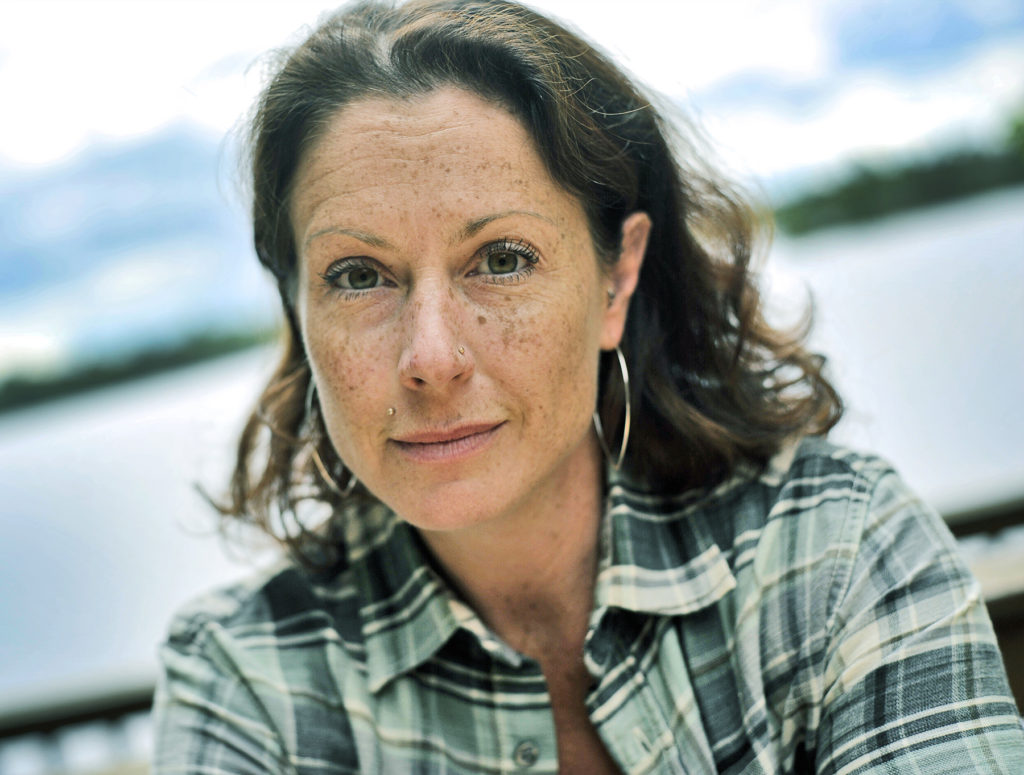A Conversation with New York Times Bestselling Author, Marya Hornbacher

As early as age 4, Marya Hornbacher recalls being on a diet… thus began her decades long struggle with body image and an all-consuming quest to starve herself to death. Something she almost succeeded doing. In fourth grade, she became bulimic, and later, at the age of 15, she developed anorexia.
Marya shares, “I fell for the great American dream, female version, hook, line, and sinker. I, as many young women do, honest-to-God believed that once I Just Lost a Few Pounds, suddenly I would be a New You, I would have Ken-doll men chasing my thin legs down with bouquets of flowers on the street, I would become rich and famous and glamorous and lose my freckles and become blond and five foot ten.”
Instead of experiencing a Barbie-like existence, Marya’s life was fraught with difficulty. She endured five lengthy hospital stays, endless therapy, and the loss of family, friends and jobs, as she succumbed to her eating disorders. She even grew fur, in a phenomenon called lanugo, where the body produces hair to keep from freezing to death during periods of starvation.
Things finally reached a critical point in 1993 while Hornbacher was a college student, working as a journalist. Her weight had dropped to 52 pounds and emergency room doctors had given her just one week to live. Although Hornbacher left the hospital, she ultimately returned, checking herself in for treatment.
Today, Marya Hornbacher is an award-winning journalist, an accomplished author and a writing teacher. She’s written six books on mental illness with a seventh on the way. She’s won numerous awards for her journalism, essays, books and poetry, including the Fountain House Humanitarian Award for her mental health writing and activism.
A critically acclaimed memoir
Marya published her first book, Wasted: A Memoir of Anorexia and Bulimia, in 1998 when she was just 23 years old. The memoir was wildly popular, shooting up the New York Times Bestseller List, and even being shortlisted for a Pulitzer Prize.
Since its initial publication, Wasted has been published in 16 languages, taught in universities all over the world, and has helped thousands of people, judging from all the letters she has received over the years.
When I asked her about the book, Marya said, “When I wrote the book… my goal was to kind of blow the cover of secrecy around eating disorders and to give people a glimpse of how gruesome and devastating an experience they were.
“And, to help stop the glamorisation and romanticisation of the anorexic body as something attractive, as well as the mystique of the starving artist and all that bullshit.
“So, that was my goal. It was to really blow the cover off it. We just didn’t have the same language or understanding at that time. There was very little research about eating disorders. Treatment is not much better now, but it is somewhat better. So, I think some progress has been made. My goal with Wasted was to help facilitate that progress.”
When I asked her what she thinks health practitioners could take from the book, she responded, “I think for health workers, the most important takeaway is an eating disorder is the only disease where people actively do not want to get well.
“So, if I have cancer, my goal is to get the best treatment, best care, to contribute to my care, to advocate for myself doing all of the above. And, that’s what doctors are looking for and encouraging.
“With eating disorders, the goal is to be sick. The goal is to get sicker. The goal is ultimately to push it as far as you can.
“And so, the fundamental part of treating a patient with an eating disorder is understanding that they see their disease as something desirable. This is something I don’t fully understand, and definitely the physicians I have worked with don’t understand it either.”
Marya also sees an overlap between eating disorders and addiction that’s often overlooked by the medical community. Although eating disorders are typically viewed as a form of mental illness, she believes they’re more accurately categorised as addictions.
“Many people don’t consider eating disorders as addictions, but I am one of the people who do consider people with eating disorders as addicts.
“Eating disorder habits follow the same kind of internal logic as an addiction. And I say that as someone who is also a recovering addict from substances. The thing that drew me to eating disorders was no different from what drew me to alcohol. And, what kept me with an eating disorder was no different from what kept me drinking,” she said.
A bipolar diagnosis
A year after Marya published Wasted, she was diagnosed with Type 1 rapid-cycle bipolar disorder. The most severe form of bipolar, it’s characterised by extreme highs and lows, with rapidly changing moods.
That diagnosis was the catalyst for a second book, Madness: A Bipolar Life, written in 2007, a decade after she learned she was bipolar. As with her book Wasted, Madness also became a New York Times Bestseller. “I feel like the response I’ve gotten from people who have read Madness, whether they are clinicians or people who’ve struggled with the disorder, or people who have friends or family or partners or children who have bipolar, the most gratifying thing I ever hear from someone else as an author is, ‘You told my story’.
“My story is not terribly important in and of itself, but when it’s the story of 6 million people in the United States, that’s more significant.”
“Obviously, every book contributes to the conversation, but I like to think that I had something different to say than what had been said in memoirs about mental illness prior.
“Because, there are plenty of books by people who know people with disorders, right? There’s not enough of the narrative as spoken by the person who lives the experience. That voice is not one we hear very often,” she explains.
Marya also added that if there’s one takeaway from Madness, it’s that GPs shouldn’t underestimate their patients.
“I think there is such a tendency toward learned helplessness with mental illness and mental health disorders. We are really trained to underestimate ourselves, those of us who deal with mental illness. We’re trained to feel helpless, we’re trained to feel hopeless. We’re told, ‘Oh, you’ll never be able to do X, Y, Z, blah, blah, blah’.
“I think we are much more capable than many clinicians give us credit for or are aware of. And, so I think what I would encourage clinicians to do more often is say, ‘Okay, maybe you can’t do this, what can you do?’
“To take a strengths-based approach, rather than a ‘Okay, what’s wrong with you?’ approach. What I want to know when I go to the doctor is how are they going to help me maximise what’s right with me,” she concludes. Marya also emphasises the need for medical professionals to really listen to patients, so they can better understand their experiences with addiction and mental illness.
“There is so little of the voice of the patient out there. I say this with the utmost respect, but there’s an enormously powerful, maniacal field out there that believes it understands my experience, but never asks me about it.”
“It believes it can make great leaps in understanding mental illness without really getting the stories of people who live with mental illness.
“And, so I really just wanted to kind of, throw in my two cents, because I felt it was a common experience. I think there is a tendency in both popular culture and the medical field to think we know things we don’t know…
“Our subjectivity is really quite sidelined in some ways. And, we are seen as an object more than we are seen as individuals’ consciousnesses.”
Tackling the 12 steps
After Madness, Marya wrote the recovery handbook, Sane: Mental Illness, Addiction, and the 12 Steps. In the book, she uses her personal experiences with bipolar disorder and addiction to examine what makes the 12 Steps so challenging for those with co-occurring disorders.
“That book was really written for use in treatment facilities and in educational settings,” she says. “The understanding that people often have is that you either have addiction or you have a mental illness. And, if you have both, it’s just a shit show. That’s not totally true.
“The more research I’ve done, the more I’ve understood that there has been a very active effort to keep our understanding of mental illness and our understanding of addiction separate, and it’s a somewhat arbitrary distinction.
“Both appear in the DSM, obviously. The DSM is the Diagnostic Statistical Manual. Yours would be the ICD, or the International Classification of Diseases. It’s the thing that lists all the disorders of the mind.
“Anyways, you can read how they diagnose and classify disorders of mental health. Addiction is one of them. Other mental disorders are considered separate, and the distinction between them is really arbitrary and often, I think, very damaging.
“Addiction recovery literature does not deal with mental illness and mental health literature does not deal with addiction. That was the gap I saw.”
“So, I wrote that book so that people who deal with both addiction and a classifiable mental health disorder could find their way in the much more support group-based world of the 12 Steps. I wanted to make the 12 Steps accessible to people who are often told, ‘Well, the only reason you drink is because you have schizophrenia’. ‘The only reason you drink is because you have OCD’. ‘The only reason…’ Blah, blah, blah.
“The polarisation there is not really a useful construct. So Sane is for people who are working with addicted people with mental health disorders, or people with mental disorders who are dealing with addiction.”
When I ask how Sane differs from other books in the same genre, Marya responds, “There are bazillions of 12 Step guides, in every language and every part of the world. All of them seem to insidiously ignore diagnosable mental illness. They’re like, ‘Well, hey, we deal with alcohol addicts and drug addicts. We don’t deal with those crazy people’. And so, that’s always been a funny thing to me.
“When you get to the 12 Step programs, there is this idea that if you have mental illness, they really may not be able to help you. That’s not true.
“They are very useful for people with mental illness, and in fact, dealing with addiction is the number one thing for people with mental illness. The very first step in the healing process is getting off the substance and stopping the addictive behaviour cycle.

Marya’s journey to better understand mental illness
Most recently, Marya’s been on an incredible journal across America to investigate the state of mental health. She criss-crossed the country over five years and conducted over 1,500 interviews, culminating in her most recent book, the soon-to-be-published, We’ve Been Healing All Along: Stories of Hope on the Road to Mental Health.
Although her journey was through the United States, the insights she gleaned apply to medical practitioners everywhere. Chief among them is that people who suffer from mental illness are not throwaway people.
“They can thrive, many of them do thrive, a lot of us thrive under the wire. A lot of people are out there are just muddling through their lives, dealing with mental health issues, in a non-dramatic, non-catastrophic sort of way,” Marya explains.
“Going back again to that strengths-based approach for a moment, I really want clinicians to understand that approaching us and asking, ‘How are you broken?’ will never help us. It simply won’t help us heal.
“What I’ve learned is that people have enormous capacities for healing and recovery within themselves, until they are convinced otherwise.”
Marya would also like to remove the stigma surrounding mental illness. She says, “I mean, many sufferers are just regular mums and dads and yoga teachers and brothers and sisters. They get up every day and they do their best, like everyone else.
“Mental health disorders are simply unique facets of the human experience that only some of us deal with. It’s just the same thing as dealing with being a short person, or a tall person, you know what I mean? People are going around being short all the time and it’s not news.
“And, so part of what I wanted to do is take away the idea that mental health disorders have to be extreme, deadly, fatal, permanently life ending, permanently disabling. I want to take some of that away from it and show these incredible people that I have followed through these years now, just living their lives and that to me is thriving.
“And, what I wanted people to do when I started interviewing them, was to tell me, how do you thrive? How do you define thriving? How do you define healing for yourself?
“That’s different for different people. One guy got a PhD in political science and now he’s a university professor. While, one woman was like, ‘I’m gonna master the bus system in my town’. You know, those are different definitions, but both of these people found greater freedom.
“They found greater independence, they found greater self-sufficiency. They found a way to be in the world that was more effective compared to how they were before. And if that’s not thriving, I don’t know what is.
The standout practitioners on Marya’s journey
Along Marya’s journey, she didn’t just speak to individuals with mental illness. She also met with doctors and health practitioners to get a more well-rounded view of mental illness. During those meetings, she particularly enjoyed challenging the professionals she spoke with.
“What I loved, was meeting health practitioners and asking them, ‘Well, what do you mean by that?’ I’d challenge them on something, and they’d reconsider it. And, then they’d challenge me on something, and I’d reconsider.
“People who are really willing to listen to their patients and their clients are going to learn from us and we will learn from them, in turn. People we won’t learn from, people who won’t help us heal, are people who already know everything,” she says. Marya also really enjoyed the interviews she conducted at McLean, a psychiatric hospital in Boston that does neuroscience research.
“I was talking to one psychiatrist, and I asked, ‘How do you see your field changing?’ And, she said, ‘I don’t know what my field is’. She was like, ‘My field is human experience. I help people navigate that when I can’. That’s a humility I don’t see very often and I’d like to see more.”
Marya also holds her therapist and psychiatrist in particularly high regard. “[They] are both contrarians. They’re both willing to engage,” she explains.
“My psychiatrist and I call our sessions bibliotherapy, because mostly we talk about the books we’re reading, or writing, as the case may be. He’s brilliant, he’s wonderfully funny and he’s very much opposed to the idea that I can’t.
“When I say, ‘Oh, I don’t think I can do that’, he’s like, ‘What!’ He’s very frustrated when I say I can’t do something. And, he always questions me until I’m like, ‘Okay, so maybe, maybe, maybe, I could’.
“My therapist, similarly, treats me not as a case, not as a client, but as a thinking person. As a thinking, experiencing, imagining, creative, person. When I come in, she doesn’t say, ‘Well, how was your week?’ She lets me say, ‘You know what I’ve been thinking about? What I’ve been thinking about is this’.
“In daily life, when we take a less clinical approach to people, they respond to us. And it’s also true in medicine as well,” Marya says.

Parting words for Australian practitioners
When I asked Marya if she had any parting words for Australia health practitioners, she responded, “I really am intrigued by how much further ahead Australia is in recovery research when it comes to mental health.
“The United States is very, very bound up in funding from pharmaceutical companies, and it informs all the research that is done here. And so, there’s a huge conflict of interest for people [in the US] who want better research and better recovery strategies and in Australia you already have those.
“We don’t totally, yet. We’ll see what we can do about that, but you really live in a very forward-thinking country when it comes to mental health and that’s exciting to me, and it’s exciting to talk to you about this.”


